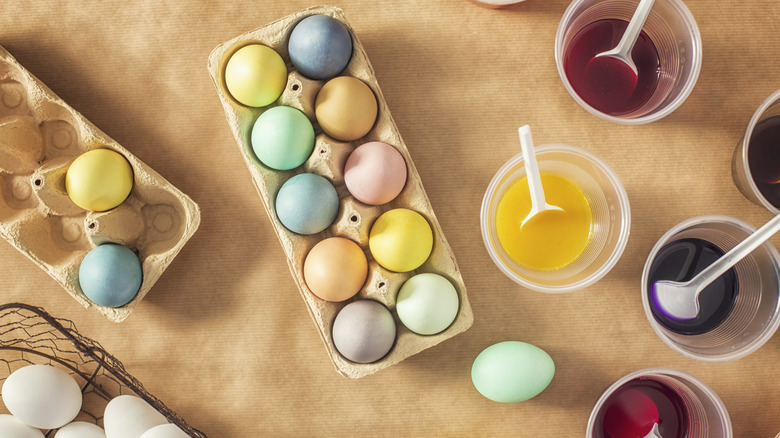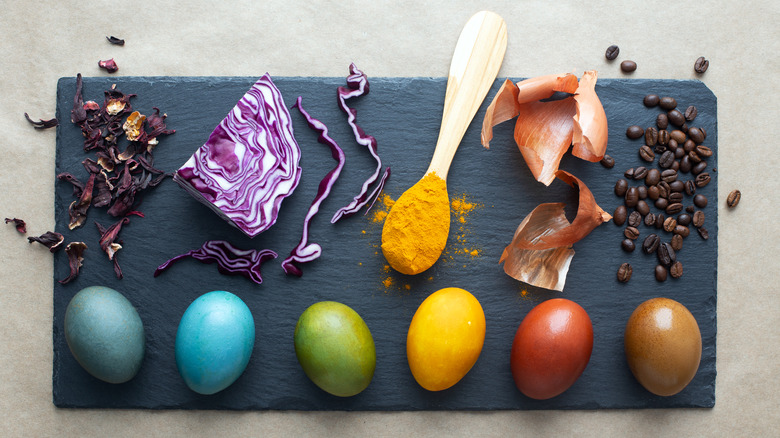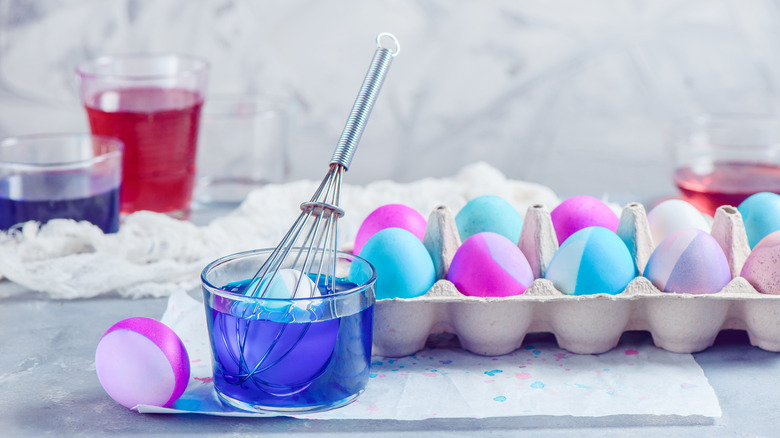How To Dye Easter Eggs With Whipped Cream And Kool-Aid
Although there are plenty of child-friendly egg-dyeing kits on the market, many parents would rather use edible colorings for their Easter eggs — after all, we all know that kids like to put their (stained) fingers in their mouths. According to Mashed, two quick and easy methods involve using whipped cream and Kool-Aid, or any generic colorful drink mix. The whipped cream creates groovy tie-dyed eggs, while the Kool-Aid is better for solid-color dyeing or painting designs.
Dyeing eggs with whipped cream is simple. Spread the cream over a baking sheet and drizzle with food dyes of your choice, then swirl gently with a spoon or chopstick to create a tie-dye effect. Roll the eggs in the whipped cream, then refrigerate for at least half an hour. After the eggs have had time to sit, rinse off the remaining whipped cream to reveal a blend of colors. For even more vibrant hues, consider soaking your boiled eggs in vinegar for two minutes before rolling them in the whipped cream.
The Kool-Aid dyeing method is just as easy. Mix a packet of the drink powder with half a cup of water, repeating the process for each color you want to use. Stir to dissolve the powder, then submerge each egg for a minute or two until the shells take on the color. Remove the eggs with tongs and set aside to dry. Way easier than trying to find naturally pink, blue, and green eggs, right?
How to make all-natural food dyes for Easter eggs
Other methods of coloring eggs can help you forgo artificial dyes altogether. Similar to how you can make a vibrant red velvet cake with beetroot powder, you can also use chopped and boiled beets to dye eggs pink (or red, if you leave them to soak in the dye for longer). Simply boil cut-up beets until the water takes on a vivid purple-red hue, then soak the eggs in the liquid for 30 minutes or longer.
To dye eggs in the purple/blue spectrum, submerge them in water from boiling red cabbage or blueberries, or you can even use red wine. Blueberries will create a very deep color, so there's no need to soak the eggs in vinegar beforehand. For orange and yellow eggs, dip them in water from boiling yellow onion skins, or water mixed with turmeric or paprika. A concentrated batch of black tea can also do the job. Last but not least, you can dye eggs (and tons of other foods) green with spinach that has been pureed and boiled.
Regardless of the colors you create, be very careful not to spill or splash the dyes on yourself. These will stain your skin, clothes, and furniture just as easily as they stain eggshells, proving difficult to completely wash out.
Tips for keeping clean while dyeing Easter eggs
Given the messy nature of dyes (both artificial and natural), it's important to use them with caution. One good rule of thumb is to wear old clothes when dyeing eggs, so it won't matter as much if you get dye on them. You should also protect your workspace with newspaper or a disposable tablecloth.
Consider using kitchen utensils to dip your eggs in dyes, rather than using your fingers. The simplest tool to transfer eggs is a spoon, but you'll have better control if you use tongs — just don't clamp them down so hard that the shells crack. A light hold is all you need. Alternatively, you can take a whisk, gently part the wires, and slip an egg inside. Just like that, you've got the perfect dipping tool, with no need to worry about dropping any eggs.
To keep your fridge stain-free, cover your shelves with plastic wrap before placing containers of submerged eggs on top. Once your eggs are soaked, then dried, you can easily remove the wrap for perfectly clean shelves.
Static Media owns and operates Food Republic and Mashed.



